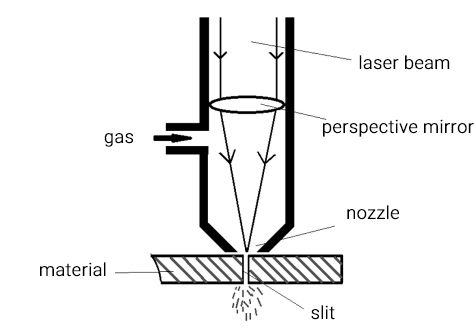Application of laser cutting technology in marine engineering
There is a huge demand for metal cutting in the field of marine engineering. The traditional metal cutting technologies are high-speed oxygen-flame cutting technology and plasma arc cutting technology. However, both of them have shortcomings such as slow cutting speed, large thermal deformation of the workpiece, and difficulty in ensuring product accuracy. As competition in the offshore engineering market becomes increasingly fierce and industry profits continue to decline, customers are becoming more and more strict on quality. Traditional metal cutting technology is unable to meet market demand and is gradually being eliminated by the market. The characteristics of laser determine that laser cutting technology has great advantages compared with other technologies. It uses high-energy laser beam to irradiate the surface of the workpiece to vaporize the material in a very short time, and then uses auxiliary gas to remove the residue. Walk to form a slit, schematic diagram of laser cutting technology. It can be seen that during laser processing, there is no direct contact between the laser and the material, and no tool is required to participate in cutting in the processing program. Therefore, there is no direct impact or force on the workpiece, and the workpiece will not undergo plastic deformation or elastic deformation. The energy of the laser beam is very high, the density is strong, the processing speed is fast, and it processes part of the workpiece, with little impact on other parts, thus avoiding the deformation of the workpiece due to heat. In 1992, the European shipbuilding company Vosper Thorny Croft assembled the world’s first laser cutting equipment and successfully applied it in the shipbuilding industry. Subsequently, the Bender shipbuilding company in the United States also installed the world’s first high-power laser cutting equipment, the Tanaka LMX III laser, to further improve the processing quality of laser cutting and reduce manufacturing costs. After entering the 21st century, fiber lasers have been widely used in the field of marine engineering cutting due to their excellent beam quality, high electro-optical conversion efficiency, small size at the same power, and better working flexibility brought by optical fiber transmission. Jae Sung Shin et al. used a 6 kW fiber laser to study the cutting performance of high-speed fiber laser on stainless steel plates; Antti Salminen et al. used a 5 kW fiber laser to study the effects of laser power, cutting speed, and auxiliary gas pressure on cutting performance and quality.

Application of laser welding technology in marine engineering
Metal plates of various materials are the most commonly used materials in the field of marine engineering. In order to assemble the plates into marine engineering equipment such as ships, offshore drilling platforms and offshore auxiliary ships, welding methods are usually used. To be done. Traditional welding methods include gas shielded welding, submerged arc welding, MIG/TIG welding, etc. These methods often generate a large amount of heat during the welding process, causing the workpiece to warp or deform due to excessive heating. Equipment manufacturing companies need to spend extra time and cost to correct these defects, which in turn affects the company’s production efficiency and profit margins. Laser welding is a new welding technology developed with the development and application of laser technology. Its welding process is of heat conduction type. The laser irradiates the surface of the plate, and heat diffuses from the surface of the plate to the inside through thermal conduction. By optimizing the specific parameters of the laser pulse, such as power, frequency, pulse width, etc., it can melt and form a specific molten pool on the local surface of the plate. Therefore, compared with traditional welding technology, laser welding does not come into contact with the workpiece and has unique advantages such as small weld seams, high strength, and high efficiency. In addition, laser welding technology and laser cutting technology can be well integrated to achieve highly automated production of offshore engineering equipment. Although laser welding technology has its unique advantages, it also has limitations that cannot be ignored, such as high precision requirements for weldment assembly, poor bridging ability of the molten pool, and poor stability of the welding process. The existence of these problems limits the thickness and efficiency of laser welding, and hinders the promotion and application of laser welding technology in the field of marine engineering. In order to solve these problems, laser-MIG/TIG hybrid welding technology has been developed. This technology combines two different heat sources, laser and arc, to process a workpiece at the same time, which can not only give full play to their respective advantages, but also make up for each other’s shortcomings. Wang Jun from Huazhong University of Science and Technology uses both a fiber laser and a MIG welder to perform laser-MIG hybrid welding on aluminum alloy plates. The deformation and stress of the workpiece after welding are very small, and the weld surface is beautiful, without pores, cracks and other common welding problems. defects, and the weld has excellent mechanical properties, with a tensile strength of 220 MPa. Beijing University of Aeronautics and Astronautics used CO2 lasers and AC and DC pulse TIG welders to conduct dual-focus laser-TIG hybrid welding experiments on 304 stainless steel. Experimental results show that double-beam rotating laser arc welding can stabilize the welding process and improve the weld quality and welding efficiency of 304 stainless steel. In addition, in addition to upgrading laser technology, scholars have also developed laser welding seam tracking technology, which can detect and control the welding process in real time. An automated welding seam detection method was developed that highly integrated the laser welding head and CCD video tracking module to achieve real-time tracking of laser welding. A. Belitzki et al. applied artificial neural network in the process of laser welding, which can predict its future deformation tendency based on the welding parameters in the local area. The comprehensive application of these technologies can well solve the related limitations of laser welding and promote in-depth research on laser welding technology in the field of marine engineering.
Application of Laser Cleaning Technology in Marine Engineering
In the marine environment, due to the influence of various factors such as seawater, sea breeze and ocean currents, the steel surface of marine engineering equipment is prone to hydrogen evolution corrosion, thus forming a loose iron oxide surface. External O atoms and H ions can diffuse into the steel through iron oxide, causing continuous oxidation and corrosion of the steel, reducing the service life and wind and wave resistance of offshore engineering equipment. Therefore, it is necessary to take measures to remove oxides on the steel surface in a timely manner, reduce the probability of accidents in marine engineering equipment, and enhance the ability to resist risks. The use of laser as a means to remove oxides from metal surfaces is a high-tech technology that has been gradually developed in recent years with the research and development of laser processing technology. It is called laser cleaning technology. This technology uses a laser beam with a certain energy to radiate on the rusted area, causing the surface to heat up rapidly and trigger a series of reactions such as thermal diffusion, thermal expansion and thermal stress, thereby causing the rust to fall off without damaging the substrate surface. As a type of laser processing technology, laser cleaning technology also has the typical characteristics of laser processing, such as high degree of automation, green and pollution-free, fine removal, easy operation and non-contact processing. Therefore, laser cleaning technology has significant advantages in complex and harsh marine environments and can be widely used in marine engineering equipment, such as deep-sea experimental drilling platforms, ship manufacturing, etc. Lu et al. from the National University of Singapore used molecular lasers to laser clean stainless steel and found that when the laser energy density is higher and the number of laser pulses is larger, the laser cleaning ability is stronger. A CO2 laser was used to remove paint from the 2024 aluminum alloy. After one laser scan, the paint layer on the surface of the aluminum alloy completely fell off, while the matrix remained intact. In addition, laser cleaning technology can produce permanent characteristic changes on the surface of marine steel materials during the processing process, such as enhanced corrosion resistance, hardness and oxidation resistance. Laser cleaning technology was used to clean the surface of the Ti-3Al-2.5V tube, and then welded, and then the changes in surface morphology, hardness, chemical composition, metallographic structure and other properties after welding were detected. Experiments show that by welding the workpiece after laser cleaning, the prepared sample has better welding quality. Rechner et al. performed laser cleaning on AW6016 aluminum alloy and used relevant detection methods to observe the changes in material properties before and after cleaning. They found that laser cleaning not only removed the oxide film on the surface of the aluminum alloy, but also enhanced the surface properties of the material. In recent years, with the rapid development of laser technology, people have developed fiber lasers with better beam quality, higher efficiency and reliability. This type of laser has a high repetition rate, a pulse width of several nanoseconds to hundreds of nanoseconds, and a single pulse energy of up to millijoules, which makes it a great advantage in laser cleaning in the industrial field, especially in the field of marine engineering. . At the same time, fiber lasers have low operation and maintenance costs, small equipment footprints, and are easy to integrate with other automation systems. Therefore, fiber laser is one of the important development directions of laser cleaning technology.
Conclusion
Laser processing technology has many unique advantages, such as high energy density, small thermal effect, and high degree of automation. The development and application of laser processing technology provides better and faster processing methods for marine engineering equipment and improves the production efficiency of marine engineering equipment. At present, modern laser processing technology has developed in the direction of intelligence, which will greatly promote the depth and breadth of application of high-precision laser processing technology in the field of marine engineering. Laser processing technology can not only be widely used in the field of marine engineering, but can also be applied to high-end fields such as aerospace, automobile manufacturing, and biomedicine. Therefore, it is necessary to promote the development of relevant domestic research work in combination with national conditions, so that laser processing technology can play an important role in my country’s maritime defense and economic construction, and promote my country’s marine engineering manufacturing industry to become a world-class one as soon as possible.


